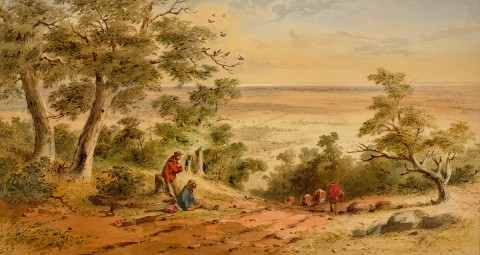VIEW OF ADELAIDE FROM BELAIR ROAD, c.1860
S.T. GILL
watercolour on paper
36.5 x 69.0 cm (sight)
signed with initials lower left: S.T.G
bears inscription on old label verso: Mrs E.M. Vidura / 20 Devonshire St / Hawthorn / Watercolour / Adelaide Plains from Mt Lofty / Ranges / by S. T. Gill.
Mrs E M Vidura, Melbourne (inscribed on label verso)
Lauraine Diggins Gallery, Melbourne (label attached verso)
Private collection
Christie’s, Melbourne, 30 July 1990, lot 136
Joseph Brown Gallery, Melbourne
The Cbus Collection of Australian Art, Melbourne, acquired from the above on 1 August 1990
Selected Australian Works of Art, Lauraine Diggins Gallery, Melbourne, 11 – 29 May 1981, cat. 6 (illus. in exhibition catalogue)
The Bus Collection of Australian Art, Wollongong City Gallery, New South Wales, 16 March – 12 April 1992, cat. 2 (as c.1845)
Overland, Latrobe Regional Gallery, Victoria, 10 March – 15 July 2012
Dawn to Dusk: Landscapes from the Cbus collection of Australian Art, Latrobe Regional Gallery, Victoria, 31 May – 16 November 2014
on long term loan to Geelong Art Gallery, Victoria
Art and Australia, Fine Arts Press, Sydney, vol. 18, no. 3, Autumn 1981, p. 214 (illus.)
Nainby, B., Stanhope, Z., and Furlonger, K., The Cbus Collection of Australian Art, in association with Latrobe Regional Gallery, Melbourne, 2009, pp. 16, 22 (illus.), 219
S.T. Gill is often remembered as the quintessential artist of the Australian goldfields, capturing with his deft line the tension, boredom, humour, celebration and desperation of that tumultuous period. However, he is less frequently remembered as an early documenter of life in the new colony of South Australia, where he lived for twelve years prior to the discovery of gold. The young Samuel Thomas – then twenty-one –arrived with his parents and siblings in December 1839, only three years after Adelaide was founded on the lands of the Kaurna people. Having received training in Plymouth and London, within three months Gill was advertising his artistic availability. In his advertisement he proclaimed his willingness to capture ‘correct likenesses’ of individuals, horses, dogs, local scenery and residences ‘sketched and… suited for home conveyance’, to record and inform distant family and friends of life in Australia.1 In addition to these genres, Gill travelled to townships around the colony, undertaking commissions including recording the early copper and silver mining industries, and participating in exploratory travels. By the mid-1840s, his lively art was being displayed in Britain to entice immigrants and investment, and appeared increasingly in printed formats, furthering his growing reputation.
This imposing watercolour is among the largest of Gill’s paintings, the wide sheet allowing him to depict the expansive view from the Mt Lofty Ranges, looking north to the distant city of Adelaide. We see Gill’s attention to detail in feathery leaves and textured bark of the gum trees that frame the steep descent, down which the plodding cattle disappear. The vibrant colours of the men’s shirts contrast with the pastel colours beyond, the changing tones of the sun-lit and cloud-shaded expanse of the plains below leading to the silver-lined horizon of the waters of the St Vincent Gulf. Gill often did not date his paintings; instead, his initialled signature evolved over the years.2 The flourishing tail of the G seen here suggests that this watercolour was painted after he had departed South Australia for Victoria in 1852, and thus would have been based upon sketches that he took with him. Its size may indicate that it was done by commission, as with his series depicting Prospect House, Adelaide, 1850 which are of a similarly grand scale.3 An earlier, looser watercolour Adelaide Plains from the road to Government Farm, 1842, shows a different aspect of the winding road to Belair, formerly the site of the government farm and the governor’s summer residence, and now the Belair National Park.4
1. South Australian Gazette and Colonial Register, 7 March 1840, p. 1, http://nla.gov.au/nla.news-article27441257
2. See R. Appleyard, B. Fargher and R. Radford, S.T. Gill: The South Australian Years 1838 – 1852, AGSA, 1986, Appendix B: Signatures and dating
3. Gill’s four views of Prospect House are in the Art Gallery of South Australia (O.1345, O.1346, O.1348, O.1349)
4. Gill, Adelaide Plains from the road to Government Farm, 1842, SLNSW, DG V*/Sp Coll/Gill/18.
ALISA BUNBURY
